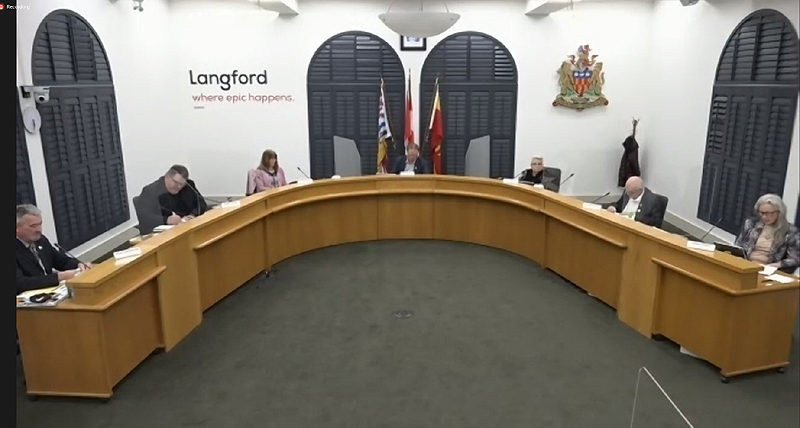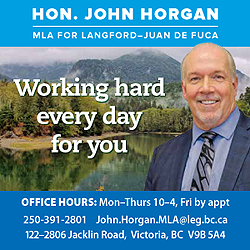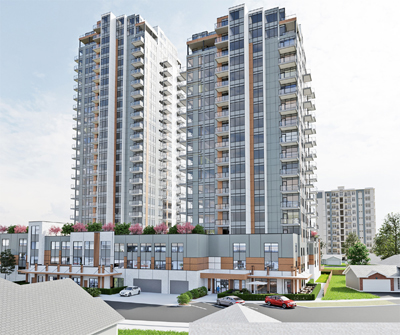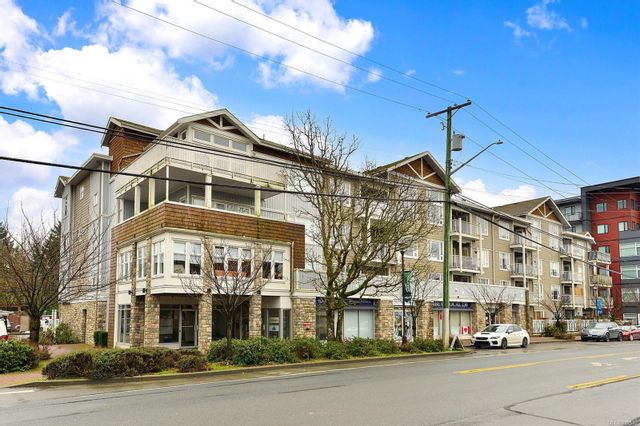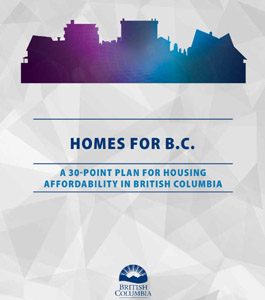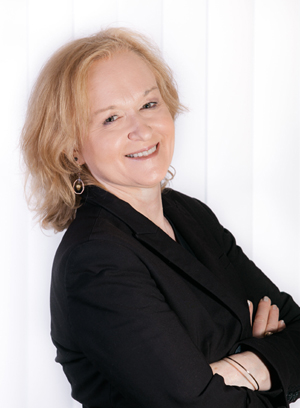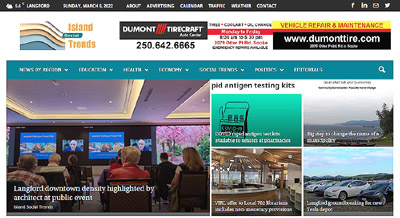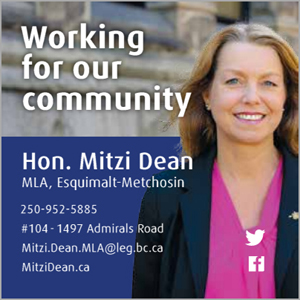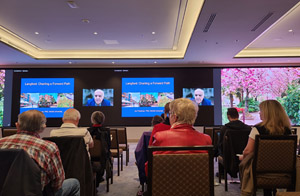
Sunday March 6, 2022 | LANGFORD, BC [Last update 10:30 am March 10, 2022 | some minor edits March 21, 2022]
by Mary P Brooke, Editor | Island Social Trends
This weekend in Langford, about 125 people heard a presentation from an architect and urban consultant who has been behind the Langford vision since 2005.
Dr Avi Friedman zoomed in from Montreal on Saturday morning via a live telecast, viewed by many of the community-active leadership of the west shore who gathered in the ballroom at the Westin Bear Mountain Resort. Attendance was free but required registration.
Pandemic considerations:
We’re still in a pandemic. The seating was set up for physical distancing and most people wore masks when mingling, but took them off while seated; BC Vaccine Cards and ID were required for entry at the door.
The room apparently has fresh air intake as part of the ventilation system that was upgraded as part of renovations done during the community slow-down phase of the COVID pandemic in 2020/2021.
Planning department in the spotlight:
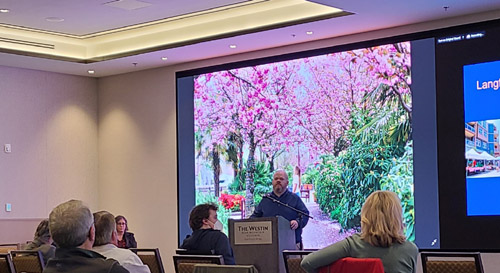
In his one-way talk that lasted about an hour and 15 minutes (plus 45 minutes answering questions from the public in the room), Dr Friedman made much mention of long-time Langford Director of Planning Matthew Baldwin. The city staffer who has guided many a development project and infrastructure installation or expansion over his years with the city is becoming known to the broader community; in addition to his deep work on numerous projects, Baldwin is the one who introduces and often answers questions about development projects during City of Langford council meetings.
In highlighting the role of staff, the architect consultant revealed that a lot of development and management of the ‘city vision’ has not only been selectively culled piece by piece by Baldwin and his staff over the years, but the staff has been given a lot of room to come up with their own components of the broader vision, for attention and consideration by council. When Mayor Stew Young and Council give new directions, that’s the green light.
Baldwin said yesterday that the city has used three volumes of Friedman’s work as the source document from which the municipality has developed and revised the Official Community Plan (OCP) and guidelines on how that is to be delivered, most notably in the city centre were density is now the goal.
“It has been a process of developing plans,” said Baldwin. Over 30 years, the city’s planning department has been instrumental in developing first the OCP, then the downtown revitalization strategy (including when city hall was new), and being involved in the Capital Regional District’s first regional growth strategy (the most recent of which was adopted in 2018, now including 2021 population projections).
Triad of momentum:
Consultant, planning staff and council. With will and energy applied, it’s a triad with momentum.
“Dr Friedman has been the guiding architect of the city’s OCP,” said Mayor Young in his introductory remarks yesterday. In counterpoint, Friedman commended city staff and council for availing themselves of his expertise.
Friedman said that the Director Planning has had much to draw upon from his vision plans, and has been keen to do so. However, one weakness of this approach is that pieces of a puzzle do not a whole picture make. The buffer zone is that Langford does seem to keep moving forward and making progress, so if something seems aberrant it soon becomes blended into a mix that catches up with it.
Langford commitment:
The City of Langford says it is “committed to building an inclusive and vibrant community complete with world-class amenities and infrastructure for Langford residents”.
That statement was embedded in one of the paper handouts at Saturday’s session.
Friedman’s role in ‘best city’:
Friedman has visited Langford eight times over the last 18 years (in 2005, 2006, 2009, 2011, 2012, 2017, 2018 and now virtually in 2022) with ideas packaged into proposals somewhat customized for application in Langford. He was introduced by Mayor Young at yesterday’s event, who gave the urban thinker “great credit” for how Langford has developed.
Professor Friedman’s biographical profile includes achieving a Masters from McGill and a PhD from the University of Montreal, creating an affordable homes program at McGil, receiving a Lifetime Achievement Award from Sustainable Buildings Canada, and penning 25 books. His public presentation style is a blend of professorial oratory and sales pitch, which seems to fit about right for the broad spectrum of active community players in the Langford audience.
Praise was heaped on Friedman. “He’s helped us to be ‘the best city in BC’ in the last two years and ’18th best city to live and work and raise a family’,” the mayor said yesterday.
The labels of ‘best city’ and ’18th best to live and work’ were awarded by BC Business Magazine (a division of Canada Wide Media) using analytics by Environics Analytics. Data can only produce the results based on parameters that are input in the first place. One of the newest parameters is rental vacancy rates as a barometer for housing availability. Another new one was an economic diversity indicator to consider how well-represented different industries are among the city’s employed residents.
Always in search of the ‘biggest and best’, Langford’s mayor highlighted yesterday that Dr Friedman was named by Wallpaper Magazine as one of 10 people from around the world “most likely to change the way we live”. Langford has significantly bought into that narrative, relying on one source of input at the top (versus a collaboration of urban thinkers), and working with the intel in a strident Langford way.
The density declaration:
As Mayor Young as has explained many times, density provides more places for people to live, more incentive for businesses to set up shop (including companies that might move their offices to Langford, such as Plexxis is doing as announced last September), and a more vibrant ambiance of urban lifestyle.
The new West Shore University is coming to downtown Langford (on Goldstream Avenue) as one example of a how far the city has come from being known as ‘Dogpatch’. That label is now destined for the history books, done and gone.
Public input:
To the credit of Mayor and Council, a public question opportunity was made available yesterday. But that was under the gaze of the creator of the plan and in the presence of the business and political community that enables it. It was good community leadership, a safe way to expose ideas while still maintaining control.

The core of complaints from the public expressed over the few years at council are essentially about the evident points of disconnect, as well as that the public feels that it has largely not been listened to. Mayor Young has been heard many times over the years countering that with saying he’s out in the community listening to people all the time. But that’s not the same as a public interface. So things do appear to be changing.
Council accepting comments in a formal council meeting is foreign to most people in the community, and the council format of receiving public input comes at the tail end after most of the planning has been done.
As for the sense of disconnect: some things move ahead rather brilliantly (like providing more homes for people to live in — almost every speaker professes to being in favour of development) while other aspects of urban change or development are minimal or starkly absent (such as any sort of emphasis on sustainability such as preserving natural ecosystems or facilitating urban food gardens).
Or some things are morphed into something unintended or aberrant (like artificial turf to stand in for real green space, or brightly bold pop-up play spaces with rubberized surfaces that offer safety but are apart from any surrounding natural ecosystem).
Some of the public comments:
Dr Friedman gave lengthy responses to these questions from members of the public on March 5:
- Not a lot of visual examples in the presentation of new innovative development in Langford over the past 17 years (mostly were from countries in Europe and other parts of the world).
- About the vision as presented: “We don’t really see that happening right now. How can they (Council) follow that direction?”
- There needs to be more support for public transit (in the west shore).
- There needs to be more integration of green spaces and community gardens. “We see a lot of scraping all the trees off and pouring of concrete.”
Menu approach:
Some ideas get started and grow in Langford because they do jive with public sentiment and are easily defined and delivered, like the provision of EV charging; new strata and commercial buildings will have various stages of city EV charging requirements and there are a couple of EV plug-in locations along Goldstream Avenue in the downtown strip. Other things that seem easily moved ahead are a few outdoor playpark areas (usually when land is made available by developers) and the many bus shelters (when BC Transit provides the shelters, Langford Engineering does the roadside prep).
This cobbling together — a menu approach, if you will — has nonetheless underpinned Langford’s many years of achieving steady population growth to now over 50,000 people (along with a greater overall tax base), even though some things stick out like a blossom in a hay field (e.g. the hastily upgraded former Westhills Stadium, now Starlight Stadium) while other things are missing (e.g. natural moments of greenspace or cultivated gardens within the higher density development — neither of which is truly matched by tightly controlled landscaping displays).
“Merging into a complete community”:
Langford has grown in fits and starts, one project after another. In just the past five years there have been grand openings for the Bear Mountain Parkway, West Shore Parkway, and the stadium expansion, as well as a lighter touch for bringing many other things to town including the Pacific FC indoor training center, the Boulder House training facility, just this past week the announcement of a Tesla service centre coming to town, and so on.
Mayor Young used a new phrase yesterday, i.e. “merging into a complete community”. Prior to now it’s been about singular highlights, not necessarily woven together to articulate the vision.
“With each visit Dr Friedman has inspired staff, council and our committees with ways in which Langford can continue to grow, prosper and merge into a complete community and large city. With taller buildings incorporating attainable housing above vibrant shops, day cares, and businesses on the ground floor,” said Mayor Young, who noted that Friedman provides examples “from around the world”.
A public comment later in the day included ‘why from around the world?’ as there were not very many examples in Dr Friedman’s presentation of where Langford has applied the Friedman vision. Specific tall buildings as proposed for downtown Langford were not featured, even though the entire event was clearly intended to normalize that.
Charting the Langford course:
For Langford, Friedman’s approach seems to be about inspiring and igniting, then leaving it to Langford to chart their own course.
“There is always something in Avi’s presentations that we as council can take away, and grow and build upon,” said Stew Young, who is a do-it-yourself political planner for his community, taking pride in what can be done ‘the Langford way’.
That historically has included being done to a schedule of ‘on time and on budget’, driven by a philosophy of ‘whatever it takes’.
In contrast to Dr Friedman’s 2017 presentation which focused on inspiring different housing types, particularly for smaller lots, in 2018 the city’s ask of the architect consultant was about how Langford could develop density in the city core. That included creating a “more walkable, affordable, and economically vibrant core”, said Young. The agenda for increased density has been in the works since then. Now, after the interruptions of the pandemic, the density plan has been publicly unveiled.
Friedman himself said yesterday that the City has leaned heavily on his singular advice over the past many years. But he did gently point out during his talk that some components of his vision have not yet been adopted in Langford. In that light he emphasized inter-building pathways and rooftop gardens. For that to happen, the precursor is taller buildings, aka density. This comes at a time when several downtown high-rise buildings are in the development stage or already built and now redefining the landscape.
Not all of Dr Friedman’s ideas have been picked up and applied within Langford, at least not so far. A few speakers from the public pointed out that inner-town green spaces are minimal and the idea of facilitating urban food gardens has not yet been tried. A good proportion of the ‘green’ along Langford’s major roadways is artificial turf — not quite within the sustainability theme that Friedman highlighted in the 2022 Vision plan.
By contrast, Friedman’s entire presentation not once mentioned child care facilities. But Langford has done work in the past few years to enable new child care enterprises in the area (supported in part by funding from the provincial government).
For sure, more housing has been developed in Langford, some of it with creative layouts and designs. In Langford there are some significant geographical challenges — including a lot of rock that requires blasting and/or innovative housing and landscaping adaptation, none of which has ultimately impeded community growth (though it has probably contributed in part to increased housing costs). If the population of young children in the community is any indication (about 300 to 400 new students registering to attend SD62 public schools each year), the housing development pace is pushing hard and fast.
Steady, visionary leadership:
Friedman credits “a steady and visionary leadership” for many of the successes achieved by Langford in the mayor’s mission to grow the town into an expanding modern metropolis. “He’s been here working with our staff and council for the last 18 years,” said Young.
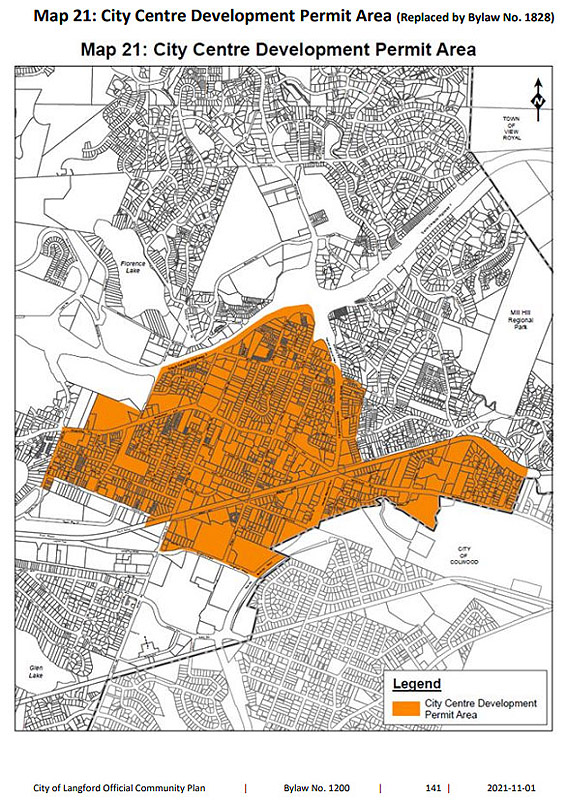
“Let’s talk about where we started out in 1992. People left Langford. There was no plan, no jobs. There was 20 percent unemployment. We’ve come a long way from ‘Dogpatch’. A lot of credit goes to Dr Avi Friedman,” said Mayor Young, noting that the architect’s first visit to Langford was in 2005. Friedman gave accolades to mayor and council for their interest in working with his ideas and bringing their community along.
“Each time we were able to update our OCP and make better economic and strategic and plans based on his information that he provided all of us,” said Young, referring to the impact of Friedman’s ideas delivered upon each of his visits.
But it could be said that picking and choosing from the ‘Friedman menu’ has been an fractious exercise. Sometimes running with one or two cool ideas or things that are seen as affordable — without cohesion to a holistic pattern of growth — leads to a result with ‘cracks in the armor’ so to speak. For example, trying out innovative housing styles has sometimes produced some odd housing designs that come with challenges (such as narrow three-storey homes that ultimately appeal to a restricted demographic) and some construction standards are economized upon (e.g. unconventional or non-existent ventilation standards in some homes in the last decade).
Tax base and home ownership:
Pushing to achieve the tax base and low tax rate that Friedman marveled about (‘doesn’t know how they did it’) has in part been achieved by allowing certain housing types that have created unusual lifestyle scenarios (e.g. large ‘mortgage helper’ homes which contain suites but create complex scenarios like one family or tenant carrying the hot water tank charges on their bill for both units without their knowledge).
Langford claims it has the lowest residential property taxes in the Capital Regional District; it usually hovers around 2.5 percent. About 68.3 percent of the tax base is from residential, with 29.9 percent from business, and 1.8 percent other (2020 figures). During 2015 to 2020 Langford says 2,716 new rental apartment units were completed in the municipality, with 512 of those at below market rental rates.
Mayor Stew Young has mastered many capitalist ways and means with many creative approaches to development (including a land swap with Metchosin and Beecher Bay in 2017 that increased the municipality’s footprint by about 354 hectares), with multiple goals of attracting more businesses, creating more projects for developers and creating a residential property investment class that has become a steady source of property tax revenue.
One of the unintended consequences of the latter project has been to also create a renter’s class who are paying such high rents in these homes that it’s tough for them to save enough money to become home owners themselves.
However, today one of the examples of Friedman’s vision — as well as patience — was pointing out that perhaps the mid-20th-century dream that everyone aspire to home ownership is perhaps not possible in today’s economic climate. People starting with a condo and then perhaps from there look at home ownership, is how Friedman put it today. But he also said that shifting “from single family home to condo… this trend is justified”, in light of the goals of affordability and sustainability. Put simply, life (and housing in particular) is just too expensive to shoot for the stars.
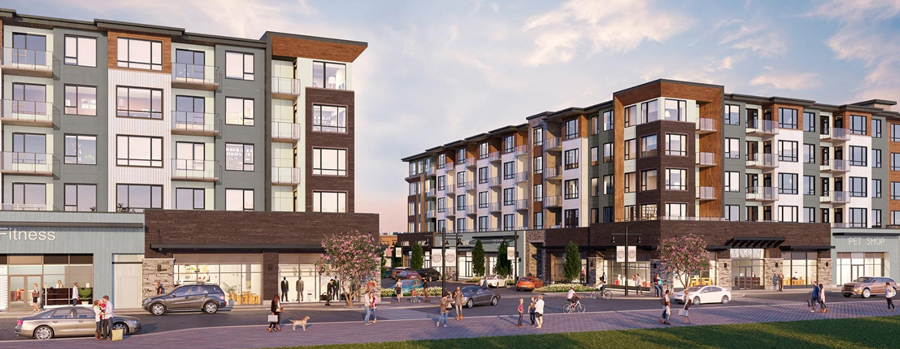
Density and attainability:
So the approach, emphasized by Friedman, is to build homes and neighbourhoods with higher density. That’s not a new idea. It’s how North American cities have developed for nearly a century. But it’s a new idea for many people who have lived in and enjoyed the open-space lifestyle of the west shore, where vehicle use is prized and parking is still free in almost all retail and commercial locations.
Density has in many ways been a tough sell for the Langford visionaries. Not so much, one surmises, due to the idea of higher density itself (many people don’t mind condo-living or row/town house streets as a lifestyle choice) but because of how it has been applied so far. People who ask questions in the public portion of Langford council meetings have well pointed out in the past year or two that Langford’s growth has not always been done with a holistic view to the neighbourhood or the environment. Not to mention the skyrocketing price of homes (and the trickle-down effect on rental prices) as the cost of development that is woven into the fees charged by the city to developers is embedded into the sale price of condos, townhomes and single family homes.

The city has grown and homes have been provided for the people who want to flock here under the lure of affordability. But with an average house price of $1,319,027 in Langford in February 2022 (remarkably up from $1,212,849 just the month before), even the mayor admitted during a recent council meeting that homes are no longer affordable in this town.
Trying a new Attainability program:
Langford’s creativity in the housing market includes their Attainable Home Ownership Program, which was announced last fall to try and match up condo developers with prospective buyers (who have already been resident in Langford for at least two years); council discussion included the idea of getting people out of renting and into home ownership.
It’s an innovative idea, even with tinkering on the qualification side of things (i.e. ‘what is a family’ had to be reviewed when there were concerns raised about the program at first only being available to single renters). The Langford political push to label the city as a ‘family community’ still in many ways reveals 20th-century ideas about what a family is. Most people would today recognize that a household is almost equivalent to a family — regardless of the number of people in a household (could be just one, with other members of that family living elsewhere as grown children); just because a household is one person now doesn’t mean it won’t be more later.
As well, a family is not necessarily adults who have children. Developing a ‘family community’ in this third decade of the 21st century would sensibly embrace all components and styles of persons who need a roof over their head. The October 2021 launch of the Attainable Home Ownership Program saw some minor amendments in January 2022, with some attempt to perhaps include seniors or other one-person households who might still aim to buy into the market; some of that push was led by Councillor Lillian Szpak.
The Attainable Home Ownership Program [Langford Program link] matches up developers and prospective buyers with units at an attainable price point (as outlined in the City of Langford’s program policy); qualified buyers would then receive up to 75% of their down payment through the City’s program.
The City of Langford Planning Department has contributed this additional description:
“The first introduction of the program was for 2-bedroom units and buyers were to include at least two people (one of which may be a dependent); singles were not eligible. It was expanded in January to include 1-bedroom, 1 bedroom plus den, and 3-bedroom units in additional to the original 2-bedroom units. At the same time the qualifying criteria were expanded to accommodate different household types for the new unit sizes, including allowing individuals to qualify for the 1-bedroom and 1+den units, and specifying a household type of at least two persons (one of which must be a dependent) for the 3-bedroom units. The 2-bedroom unit criteria remained the same.”
Aging in place:
Which brings us back to a key point made this weekend by Dr Friedman… that housing and communities must now figure out how to facilitate ways for seniors to age in place. That’s clearly more affordable and safer (from a public health standpoint) than shunting elderly people into communal living facilities. Aging in place is about more than just the four walls of housing, but having that interwoven with a range of community supports (for which provincial and federal levels of government do provide some funding arrangements).
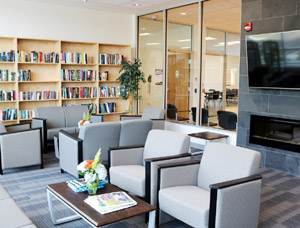
With co-funding from other levels of government (as well as local community services and/or non-profit organizations), any municipality that seeks to achieve the goal of aging-in-place will benefit by articulating that as a priority. Then facilitate the ways and means for that vision to materialize. Land can be designated and funds earmarked.
First a condo, then larger home:
So there is condo living as a desirable alternative to the ‘home in suburbia’ dream. Not a new thing there either. Condos have been filling up the vertical airspace in cities in earnest since the 1980s, with so much of a boom in Greater Victoria in that regard in the 1990’s and 2000’s that almost no apartment buildings were built in this southern Vancouver Island region for nearly 30 years. A mortgage brokerage sector which really pushed that, and developers bought in.
Prior to the Canadian government’s post-war policy-driven homeowner dream it was rarely the case that people moved into a big house at the start of their adult lives. The way the economy has been strained over the past 10 to 20 years, things are really heading back to reality… i.e. buy what you can truly afford.
It should be noted that when the current NDP provincial government found its way to power in mid-2017 after BC’s 16-year experience with a privatization-model government under the BC Liberals, they put their thinking cap on and came up with a 10-year plan to foster an increase in housing supply (through various means and with various housing types) and address the cost of renting.
None of the programs and initiatives are quick or easy. But many affordable housing projects have already been launched in the last five years, a speculation tax took care of some of the glut of vacant homes in Vancouver and to some extent in Victoria, and a Housing Hub builds partnership with organizations that own land that can be adapted to housing. Government programs further support low-income renters, including seniors. Recently the BC Government’s proposed cooling-off period was countered by the BC Real Estate Association with a pre-offer period.
Who was there:
The March 5, 2022 “A Vision for Downtown Langford” event was attended by: Mayor Stew Young and most of Council — including Councillors Denise Blackwell, Lanny Seaton, Lillian Szpak and Roger Wade, and several senior city staff; development community leadership including West Shore Developers Association president Ron Coutre, KeyCorp Developments owner Jim Hartshorne and leads Matthew MacKay and Rebecca MacKay from Design Build Services; other municipal leadership including Saanich Mayor Fred Haynes; former MP Gary Lunn; SD62 School Board Chair Ravi Parmar and Trustee Dianna Seaton.
Some local media was present. Pre-registration was required. Refreshments were available.
===== ABOUT THE WRITER:
Island Social Trends Editor Mary P Brooke, B.Sc., Cert PR has been writing about west shore region news since 2008, more directly in Langford and Colwood since 2017.
Previous to publishing under the banner of Island Social Trends, this publication was West Shore Voice News (2014-2020), and before that Sooke Voice News (2011-2013) and MapleLine Magazine (2008-2010).
Housing, affordability and socioeconomic community trends have been mainstay topics explored in all these publications for 14 years. Ms Brooke was a Realtor for a short time in the 1990s. Her publishing company Brookeline Publishing House Inc has been operating in Greater Victoria since 1995.
The full south Vancouver Island region is covered by the Island Social Trends news stream, fully online at islandsocialtrends.ca since August 2020.
Island Social Trends ENews is available free (sign up here), or by subscription (deeper articles behind the Premium Paywall).
===== RELATED:
COVID trend: Langford opens up meetings to the public (March 2, 2022)
Province: BCREA’s proposed pre-offer still carries risk for homebuyers (March 2, 2022)
BCREA proposes pre-offer period to help stabilize home-buying process (February 28, 2022)
Terminus building in Langford sets high standard for office space & services (November 5, 2021)
Plexxis tech company headquarters relocating to Langford (September 14, 2021)
Crossing at Belmont renters moving into home ownership (October 30, 2019)





